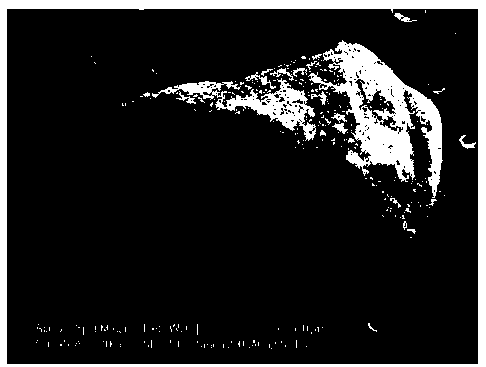Slow-release repairing material for organochlorine pesticide contaminated farmland soil
A restoration material and organochlorine technology, applied in soil conditioning materials, restoration of polluted soil, organic fertilizers, etc., to achieve high-efficiency removal, excellent removal effect, and long-term effect
- Summary
- Abstract
- Description
- Claims
- Application Information
AI Technical Summary
Problems solved by technology
Method used
Image
Examples
Embodiment 1
[0029] A method for preparing a slow-release restoration material for treating organochlorine pesticides in farmland soil, the steps are as follows:
[0030] (1) Preparation of biochar: Wash the grape vines, put them in an oven at 60°C for overnight drying, crush the dried grape vines and put them in a closed muffle furnace, first raise the temperature to 120°C for 1.0h, and then 25°C / min Raise the temperature to 650°C for 6 hours, pass the obtained biochar through a 100-mesh sieve, pickle with 8% sulfuric acid for 1 hour, wash and dry with distilled water, put it into a brown jar and seal it for storage until use;
[0031] (2) Pretreatment of zero-valent iron powder: place the zero-valent iron powder with a particle size of 120 mesh in 1.5% hydrochloric acid solution, acidify for 10 minutes, rinse with deionized water until the pH is 7, and dry it anaerobically for use;
[0032] (3) Preparation of slow-release restoration materials: a) Weigh 1.0g of biochar and add it to 100m...
Embodiment 2
[0034] To study the effect of different ratios of components on the treatment effect of slow-release repair materials, the specific steps are as follows:
[0035] Three groups of different mass percentages of biochar, zero-valent iron, organic carbon source and guar gum were used to prepare slow-release repair materials. Except for the addition of different components in the mixed solution, the rest of the operating steps were the same as in Example 1. The distribution ratio of the components in the restoration materials is shown in Table 1.
[0036] Table 1 Proportion setting of restoration material components (%, w / w)
[0037]
[0038]Weigh 100g of organochlorine pesticide-contaminated soil and place it in a 250ml brown glass bottle with a stopper, and add the restoration materials of proportions 1-3 in Table 1 therein, and the dosage is 1.0% of the dry weight of the polluted soil. The most common organochlorine pesticide is hexachlorobenzene with a concentration of 1.5m...
Embodiment 3
[0040] To study the effect of the applied amount of slow-release restoration materials on the effect of material treatment, the specific steps are as follows:
[0041] According to the preparation method of Example 1, the slow-release restoration material was prepared.
[0042] Weigh 100g of organochlorine pesticide-contaminated soil and place it in a 250ml brown glass bottle with a stopper, and add restoration materials according to 0.1%, 0.5%, 1.0%, and 2.0% of the dry weight of the polluted soil. The organochlorine pesticide in the polluted soil is hexachlor Benzene, the concentration is 1.2mg / kg. Fully mix the remediation material with the contaminated soil, and then cultivate the mixed system in an artificial climate box at 25°C for 45 days, during which the soil moisture content is maintained at 60% of the maximum field water holding capacity. After the cultivation, soil samples are taken to determine the residue of hexachlorobenzene Concentration, and calculate the rem...
PUM
| Property | Measurement | Unit |
|---|---|---|
| Particle size | aaaaa | aaaaa |
| Particle size | aaaaa | aaaaa |
Abstract
Description
Claims
Application Information
 Login to View More
Login to View More - R&D
- Intellectual Property
- Life Sciences
- Materials
- Tech Scout
- Unparalleled Data Quality
- Higher Quality Content
- 60% Fewer Hallucinations
Browse by: Latest US Patents, China's latest patents, Technical Efficacy Thesaurus, Application Domain, Technology Topic, Popular Technical Reports.
© 2025 PatSnap. All rights reserved.Legal|Privacy policy|Modern Slavery Act Transparency Statement|Sitemap|About US| Contact US: help@patsnap.com



